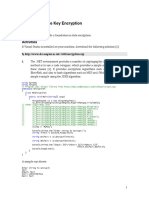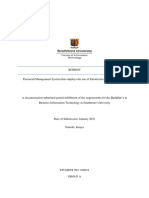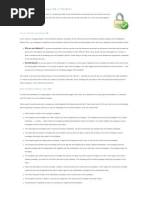Digital Signatures
Digital Signatures
Uploaded by
Chandni BathlaCopyright:
Available Formats
Digital Signatures
Digital Signatures
Uploaded by
Chandni BathlaOriginal Title
Copyright
Available Formats
Share this document
Did you find this document useful?
Is this content inappropriate?
Copyright:
Available Formats
Digital Signatures
Digital Signatures
Uploaded by
Chandni BathlaCopyright:
Available Formats
Digital Signatures
Benefits
Drawbacks
Security Issues
Benefits of digital signatures
Authentication
For example, suppose a bank's
branch office sends instructions to the
central office requesting a change in
the balance of an account. If the
central office is not convinced that
such a message is truly sent from an
authorized source, acting on such a
request could be a grave mistake.
Benefits of digital signatures
Integrity
If a message is digitally signed, any
change in the message will invalidate
the signature. Furthermore, there is no
efficient way to modify a message and
its signature to produce a new message
with a valid signature, because this is
still considered to be computationally
infeasible by most cryptographic hash
functions.
Drawbacks of digital signatures
Association of digital signatures and
trusted time stamping
The signer might, or might not, have
included a time stamp with the signature,
or the document itself might have a date
mentioned on it, but a later reader cannot
be certain the signer did not, for instance,
backdate the date or time of the signature.
Drawbacks of digital signatures
Non-repudiation
Nonetheless, a user cannot repudiate a signed message
without repudiating their signature key. It is aggravated
by the fact there is no trusted time stamp, so new
documents (after the key compromise) cannot be
separated from old ones, further complicating signature
key invalidation. Certificate Authorities usually maintain a
public repository of public-key so the association user-key
is certified and signatures cannot be repudiated. Expired
certificates are normally removed from the directory. It is
a matter for the security policy and the responsibility of
the authority to keep old certificates for a period of time if
a non-repudiation of data service is provided.
Additional security precautions
All public key / private key cryptosystems
depend entirely on keeping the private key
secret. A private key can be stored on a
user's computer, and protected by, for
instance, a local password, but this has two
disadvantages:
the user can only sign documents on that
particular computer and
the security of the private key completely
depends on the security of the computer,
which is notoriously unreliable for many
PCs and operating systems.
Additional security precautions
A more secure alternative is to
store the private key on a
smart card
Additional security precautions
The hash calculated from the document
is sent to the smart card, whose CPU
encrypts the hash using the stored
private key of the user and returns it.
It can be sensibly arranged that the
private key never leaves the smart card.
Additional security precautions
Providing a two-factor authentication
by activating PIN on the smart card.
But, keys, generated and stored on
smart cards, and often exist in
exactly one copy. Thus, the loss of
the smart card may result in loss of
private key and the corresponding
certificate may (and in fact, should)
be immediately revoked.
Additional security precautions
Using a card reader having its own
keypad is safer to enter a PIN code to
activate the smart card than using a
card reader integrated into a PC, and
then entering the PIN using that
computer's keyboard.
You might also like
- DLP Plan Final SignedDocument9 pagesDLP Plan Final SignedtmendisNo ratings yet
- v1 Script HTML Facebook DirectDocument1 pagev1 Script HTML Facebook DirectGadget FPNo ratings yet
- Software Business AnalysisDocument9 pagesSoftware Business AnalysisMohammed Fazullah KhanNo ratings yet
- CCNAS - Ch7 - Cryptographic SystemsDocument88 pagesCCNAS - Ch7 - Cryptographic SystemsVishal AvhadNo ratings yet
- Microsoft PKI and Certificate ServicesDocument32 pagesMicrosoft PKI and Certificate ServicesShane Hartman100% (1)
- IIS 6 ArchitectureDocument20 pagesIIS 6 ArchitectureRaj ChaurasiaNo ratings yet
- Payment Application Data Security Standard:: Frequently Asked QuestionsDocument4 pagesPayment Application Data Security Standard:: Frequently Asked QuestionsTheresa ZhangNo ratings yet
- Hacking WirelessDocument7 pagesHacking WirelessDeandryn RussellNo ratings yet
- Data Science Training On Statistical Techniques For AnalyticsDocument154 pagesData Science Training On Statistical Techniques For AnalyticsArun Kumar GNo ratings yet
- Chapter 04Document30 pagesChapter 04crazz1No ratings yet
- Security Architecture and DesignDocument38 pagesSecurity Architecture and DesigndonweenaNo ratings yet
- Kerberos X509Document31 pagesKerberos X509GeorgeStenNo ratings yet
- XML Security: K.Saranya KCTDocument34 pagesXML Security: K.Saranya KCTMohan Kct0% (1)
- Crypto Key ManagementDocument31 pagesCrypto Key ManagementFachrizal Rizky FerdiansyahNo ratings yet
- EAI Architecture Vodafone IndiaDocument11 pagesEAI Architecture Vodafone IndiaacetaleleNo ratings yet
- Introduction To CryptographyDocument39 pagesIntroduction To CryptographySubburam SivakumarNo ratings yet
- Digital Certificate and SignatureDocument51 pagesDigital Certificate and SignatureChandni Bathla100% (5)
- Chapter 14 Key Management and DistributionDocument40 pagesChapter 14 Key Management and DistributionNimas APNo ratings yet
- Software Design (Lecture 4)Document118 pagesSoftware Design (Lecture 4)louis benNo ratings yet
- Information and Network SecurityDocument36 pagesInformation and Network SecuritySarah Al-FayoumiNo ratings yet
- Secure Socket LayerDocument51 pagesSecure Socket LayerRaviNaganathanNo ratings yet
- Lab 3a: Private Key Encryption: DetailsDocument37 pagesLab 3a: Private Key Encryption: DetailsPhùng Đức ThắngNo ratings yet
- 9.3.1. A Secure Conversation Using Public-Key CryptographyDocument4 pages9.3.1. A Secure Conversation Using Public-Key CryptographyTanusri GhoshNo ratings yet
- Web Security and Email SecurityDocument57 pagesWeb Security and Email Securityprajwol neupaneNo ratings yet
- PA DSS Requirements and Security Assessment Procedures 1.2Document50 pagesPA DSS Requirements and Security Assessment Procedures 1.2muratNo ratings yet
- Network Security by M.Vineeth KumarDocument72 pagesNetwork Security by M.Vineeth KumarPranavNo ratings yet
- Security Testing: How Security Testing Is Different Types of Security Attacks Threat ModellingDocument18 pagesSecurity Testing: How Security Testing Is Different Types of Security Attacks Threat ModellinganilNo ratings yet
- 03 2D Viewing (Engl)Document4 pages03 2D Viewing (Engl)saurabh3112vermaNo ratings yet
- White Paper Teamcenter Security ManagementDocument10 pagesWhite Paper Teamcenter Security ManagementHeriberto100% (1)
- 3001 Mfa Best PracticesDocument14 pages3001 Mfa Best Practicesmaldonado.ogNo ratings yet
- The Public Key InfrastructureDocument6 pagesThe Public Key InfrastructurekajulovNo ratings yet
- Public Key InfrastructureDocument10 pagesPublic Key InfrastructureYUVASHRI V PSGRKCWNo ratings yet
- Lab3 CryptographyDocument5 pagesLab3 CryptographyKenshiNo ratings yet
- Securing Car-To-X European InitiativeDocument12 pagesSecuring Car-To-X European InitiativeSamian KaurNo ratings yet
- Two Factor AuthenticationDocument45 pagesTwo Factor AuthenticationJijo JamesNo ratings yet
- Unit 8Document42 pagesUnit 8Tin SiocoNo ratings yet
- OpenSSL TutorialDocument6 pagesOpenSSL Tutorialmustafadukureh100No ratings yet
- Securing Web PortalsDocument12 pagesSecuring Web PortalsPietro VivoliNo ratings yet
- Exemplifier Paper 1 Network SecurityDocument12 pagesExemplifier Paper 1 Network Securitybike0ne100% (1)
- Kerberos NotesDocument9 pagesKerberos NotesC.RadhiyaDeviNo ratings yet
- 3 - Tier ArchitectureDocument36 pages3 - Tier ArchitectureSanjeev SarmaNo ratings yet
- Secure Software Development LifecycleDocument34 pagesSecure Software Development LifecycleasattarNo ratings yet
- AES-RSA Hybrid CryptographyDocument16 pagesAES-RSA Hybrid Cryptographyvikram420shergilNo ratings yet
- Cybersecurity For Offshore Oil and GasDocument28 pagesCybersecurity For Offshore Oil and GasIsioma1No ratings yet
- Fortanix SDKMS DatasheetDocument4 pagesFortanix SDKMS Datasheetvlado.vajdicNo ratings yet
- Pci Compliance ToolkitDocument17 pagesPci Compliance ToolkitSola DelNo ratings yet
- PA-DSS Compliance With Commerce Toolkit For ApplicationsDocument9 pagesPA-DSS Compliance With Commerce Toolkit For ApplicationspymntsNo ratings yet
- (IBM Security) IBM Security QRadar Installation GuideDocument54 pages(IBM Security) IBM Security QRadar Installation Guidehiehie272No ratings yet
- View of An Object in 3 D Is Similar To Photographing An ObjectDocument59 pagesView of An Object in 3 D Is Similar To Photographing An ObjectGps KangNo ratings yet
- Project 2 Final DocumentationDocument57 pagesProject 2 Final Documentationsimonkimani422100% (1)
- Cloud Security EssentialsDocument22 pagesCloud Security EssentialsHarshithNo ratings yet
- QRadar VFlow BrochureDocument2 pagesQRadar VFlow BrochurejxjamesNo ratings yet
- Cloud Top10 Security RisksDocument35 pagesCloud Top10 Security RisksJay ShrotriyaNo ratings yet
- Overview of ISO 27KDocument8 pagesOverview of ISO 27KSuhas AgawaneNo ratings yet
- Network Security - KerberosDocument15 pagesNetwork Security - KerberosebinVettuchirayilNo ratings yet
- Cloud Computing Security TestingDocument12 pagesCloud Computing Security Testingmdrafi555No ratings yet
- Secure Code Review JavaDocument83 pagesSecure Code Review JavaDheeraj SinghNo ratings yet
- ALS Security+ Lab01Document10 pagesALS Security+ Lab01Mishel JiménezNo ratings yet
- Computer security incident management Standard RequirementsFrom EverandComputer security incident management Standard RequirementsNo ratings yet
- Audit: Date Type User MessageDocument1 pageAudit: Date Type User Messagesuwarno sanusiNo ratings yet
- WS Inf3510 2012 L05 QaDocument4 pagesWS Inf3510 2012 L05 QaSundresan PerumalNo ratings yet
- How Does SSL or TLS WorkDocument7 pagesHow Does SSL or TLS WorkHenryNo ratings yet
- Telecommunication Security: Herbert Bertine Chairman, ITU-T Study Group 17Document92 pagesTelecommunication Security: Herbert Bertine Chairman, ITU-T Study Group 17Ashish ShuklaNo ratings yet
- Silberschatz and Galvin: SecurityDocument16 pagesSilberschatz and Galvin: SecurityFyruz FyFiveNo ratings yet
- 377-Bca 601N - (D)Document24 pages377-Bca 601N - (D)Tejas SinghNo ratings yet
- A Performance Analysis of DES and RSA PDFDocument6 pagesA Performance Analysis of DES and RSA PDFRamu KuchipudiNo ratings yet
- Chirag Project Report - MergedDocument57 pagesChirag Project Report - MergedhackerformalNo ratings yet
- Ch02 - Classical Encryption TechniquesDocument52 pagesCh02 - Classical Encryption TechniquestaheralkekeNo ratings yet
- Cyber Security Basics Protecting Yourself OnlineDocument10 pagesCyber Security Basics Protecting Yourself OnlinehighfveNo ratings yet
- Ppars2 Security (Pci Comp)Document7 pagesPpars2 Security (Pci Comp)Alex PiasetskiyNo ratings yet
- 3DES Triple DESDocument14 pages3DES Triple DESVijay AgrahariNo ratings yet
- Sunmi KLD KeyManagement V2.101Document7 pagesSunmi KLD KeyManagement V2.101pratimNo ratings yet
- Computer SecurityDocument43 pagesComputer SecurityViraf PatrawalaNo ratings yet
- KerberosDocument20 pagesKerberosRamyaNo ratings yet
- Planning de Estudio Con S4vitar (Preparación OSCP, OSED, OSWE, OSEP, EJPT, EWPT, EWPTXv2, ECPPTv2, ECPTXv2) - HackTheBoxDocument21 pagesPlanning de Estudio Con S4vitar (Preparación OSCP, OSED, OSWE, OSEP, EJPT, EWPT, EWPTXv2, ECPPTv2, ECPTXv2) - HackTheBoxLuis SegadoNo ratings yet
- Security Information and Event Management ToolsDocument5 pagesSecurity Information and Event Management Toolskuldeep68538No ratings yet
- SafeNet Authentication Client 10.8 R8 Windows Release NotesDocument25 pagesSafeNet Authentication Client 10.8 R8 Windows Release NotessanjkoNo ratings yet
- MalwareDocument2 pagesMalwareJaren EntoteNo ratings yet
- Network Security and EcommerceDocument49 pagesNetwork Security and EcommerceElisha NdhlovuNo ratings yet
- Ebook - Data Recovery StrategyDocument13 pagesEbook - Data Recovery StrategyJaqueline BarcelosNo ratings yet
- Data Security and Encryption CS465Document12 pagesData Security and Encryption CS465waqas jaanNo ratings yet
- Citra LogDocument5 pagesCitra Logjustsom3antNo ratings yet
- Towards Post-Quantum Blockchain A Review On Blockchain Cryptography Resistant To Quantum Computing AttacksDocument26 pagesTowards Post-Quantum Blockchain A Review On Blockchain Cryptography Resistant To Quantum Computing AttacksViraj BhosaleNo ratings yet
- 3 Lines of Defence - IT AuditDocument29 pages3 Lines of Defence - IT AuditAnjali MahajanNo ratings yet
- Unit 5Document59 pagesUnit 5Shirly NNo ratings yet
- Notice Regarding Nuid Card RenewalDocument11 pagesNotice Regarding Nuid Card RenewalNilakshi Barik MandalNo ratings yet
- CC Exam 1-CombinedDocument68 pagesCC Exam 1-CombinedbakieNo ratings yet
- Open SSLDocument15 pagesOpen SSLlatokhanNo ratings yet

























































































